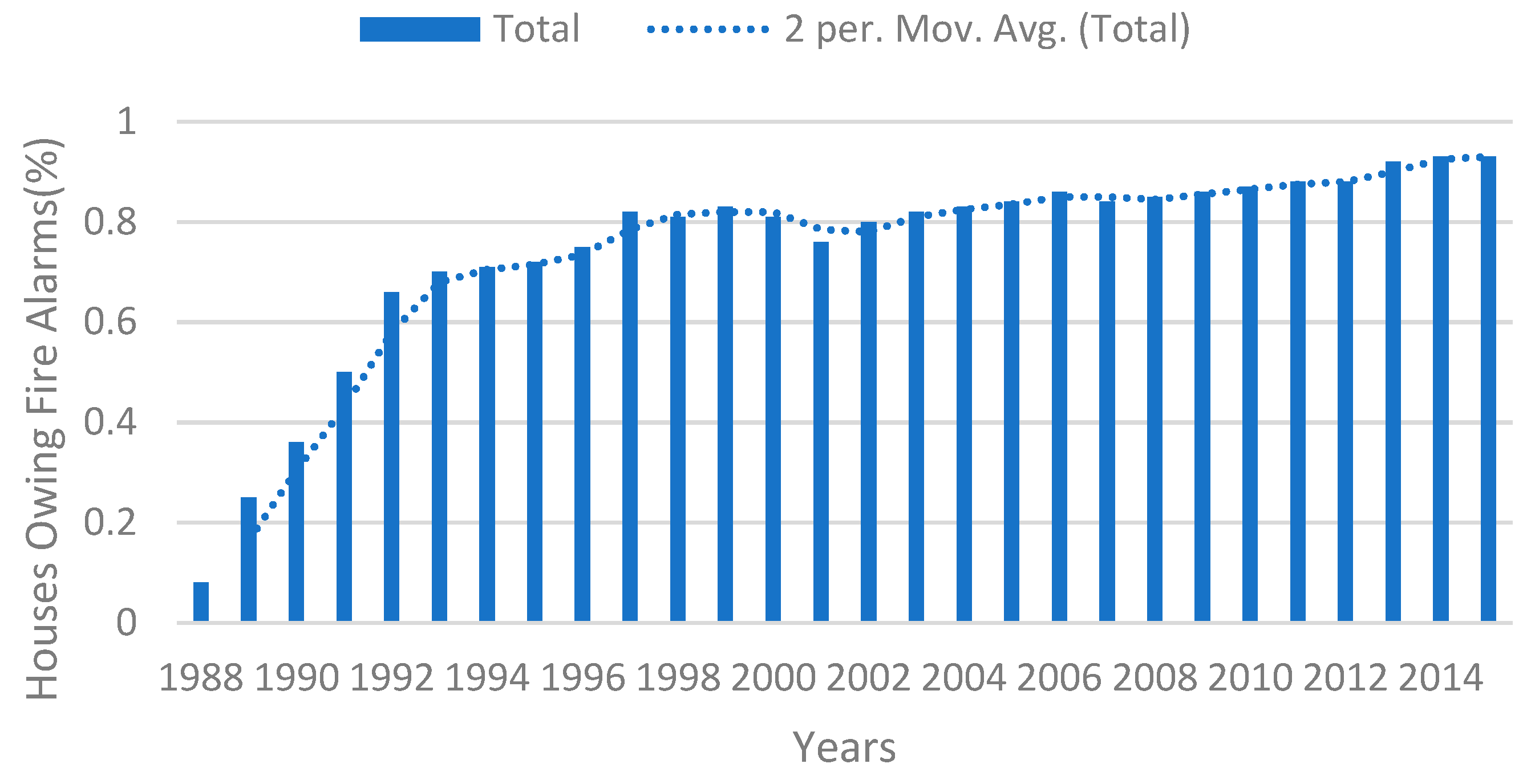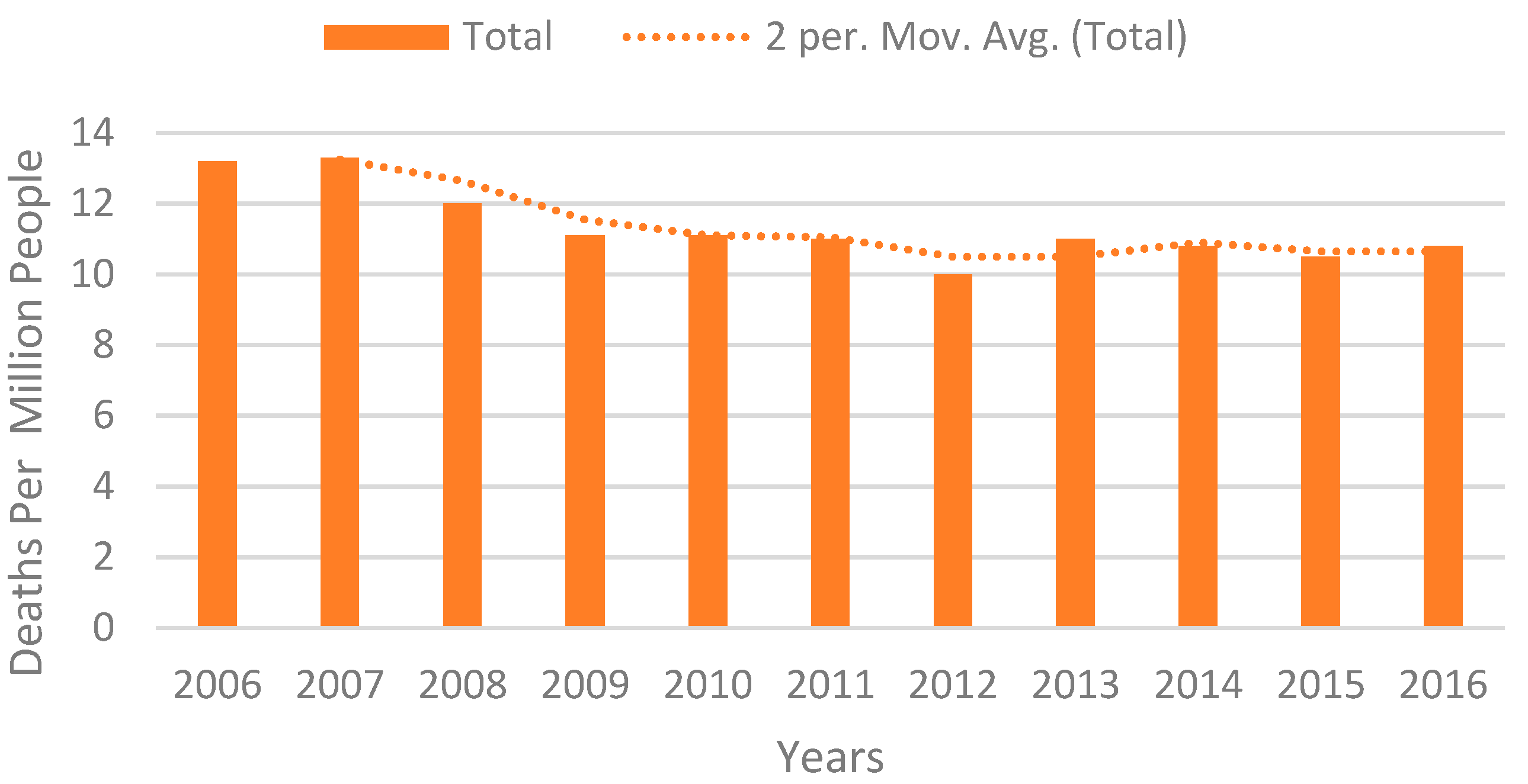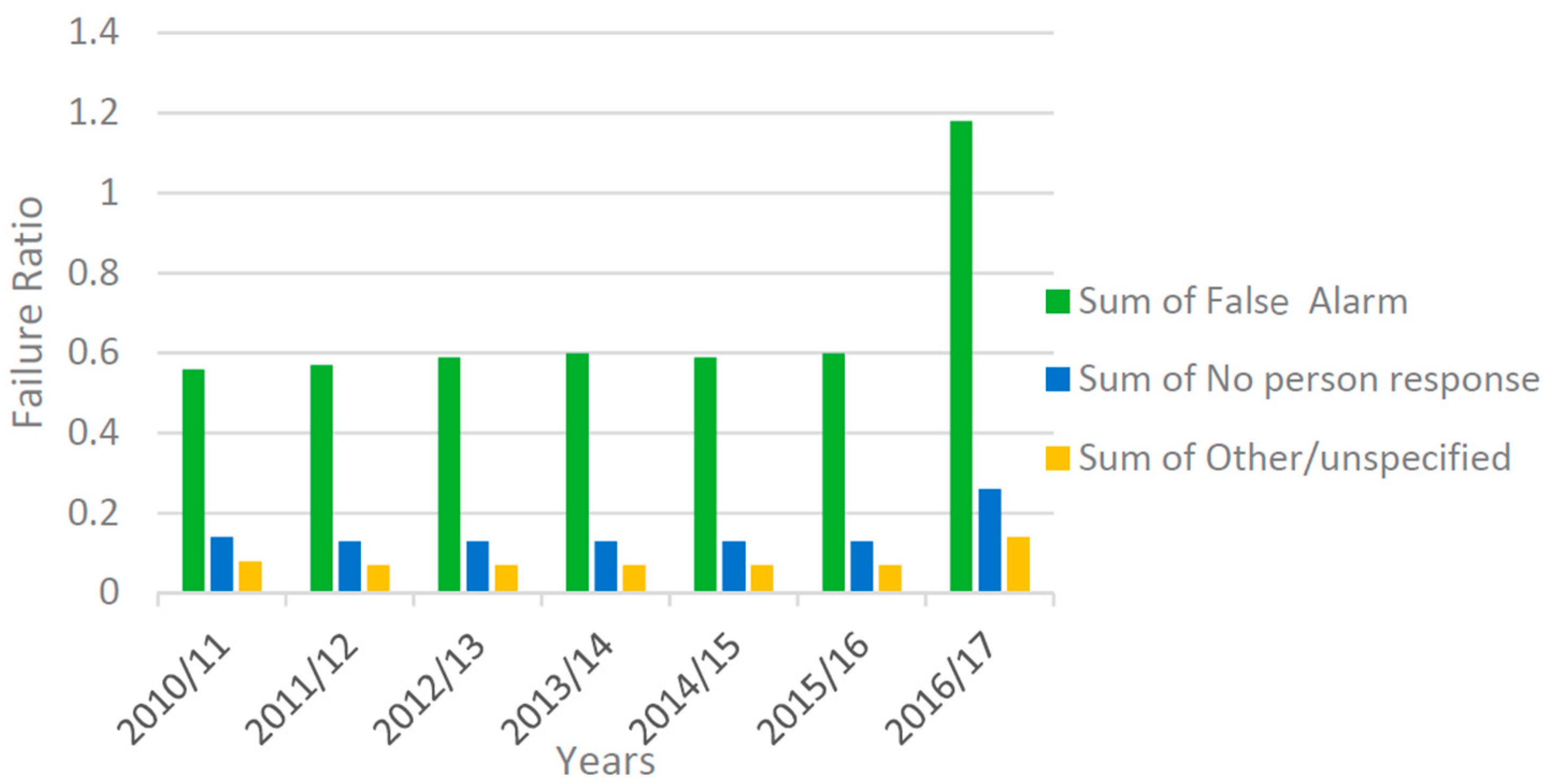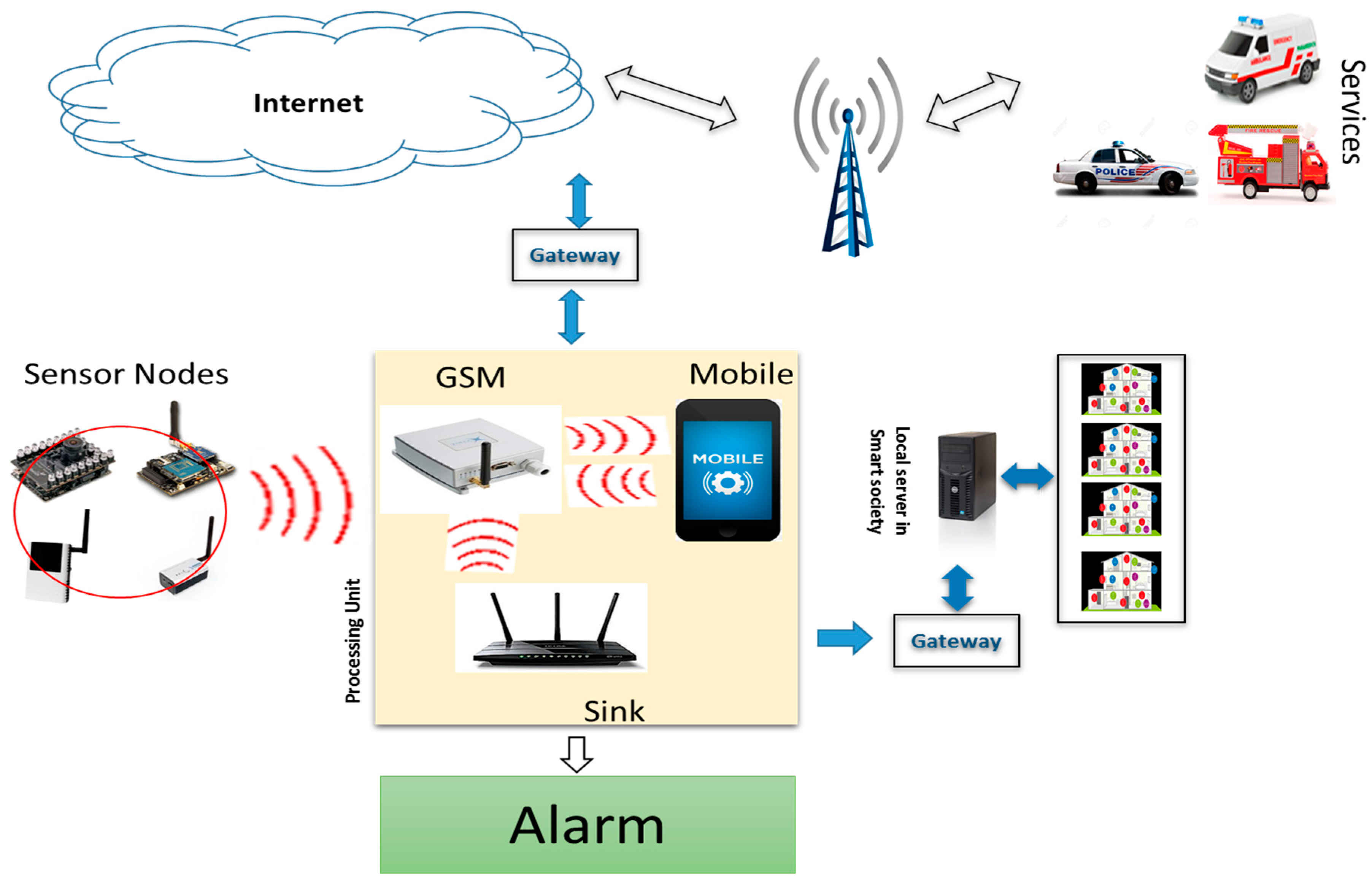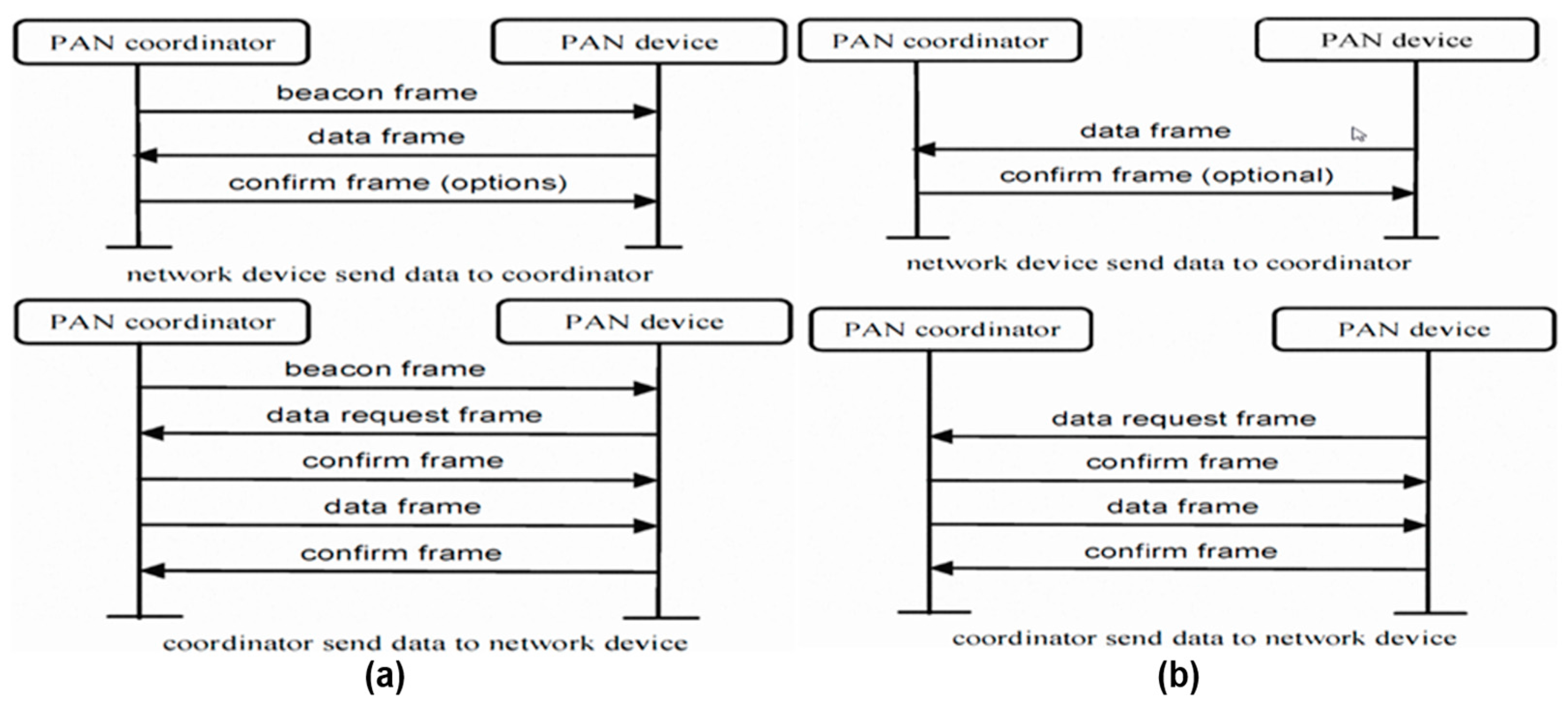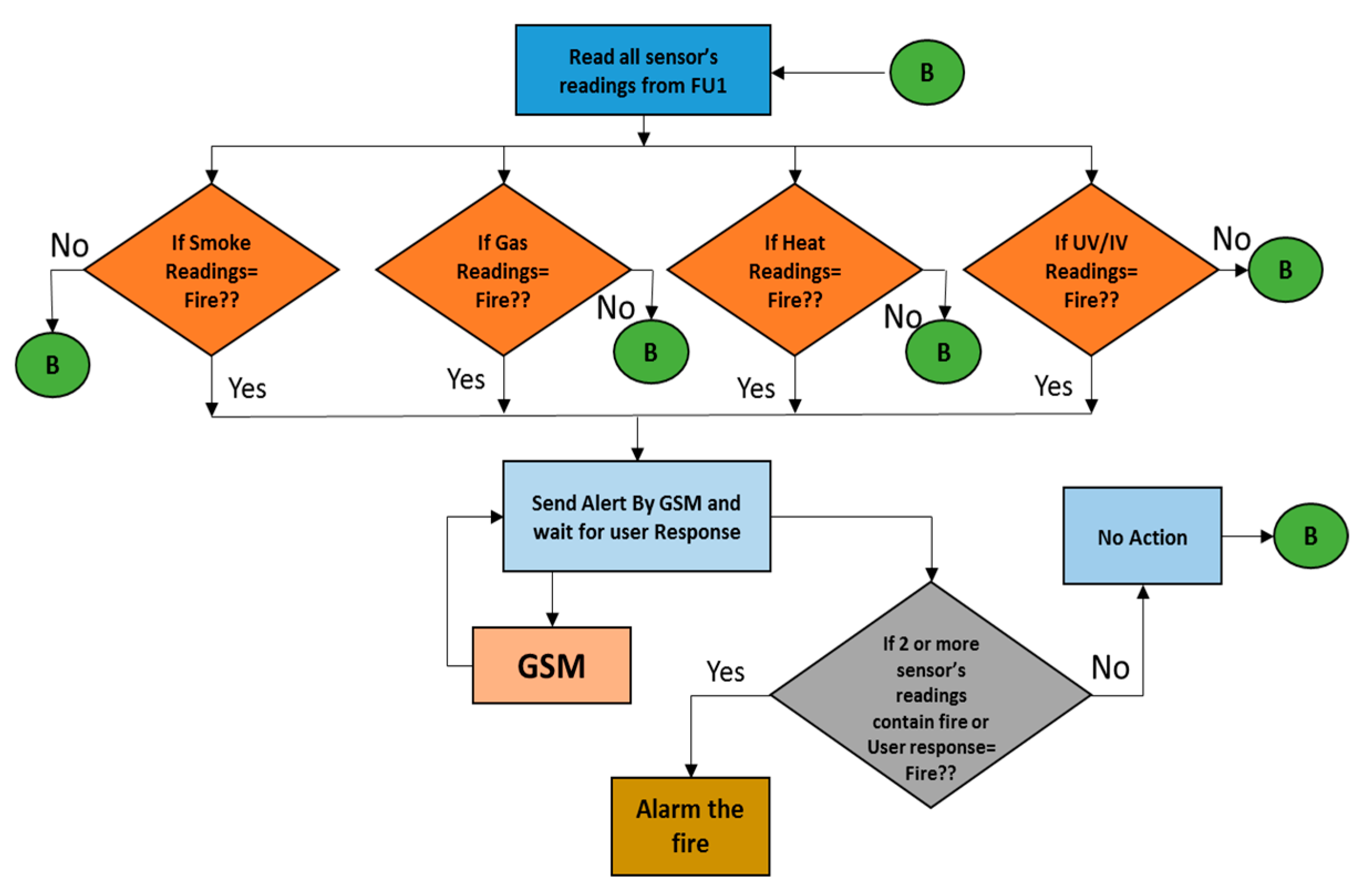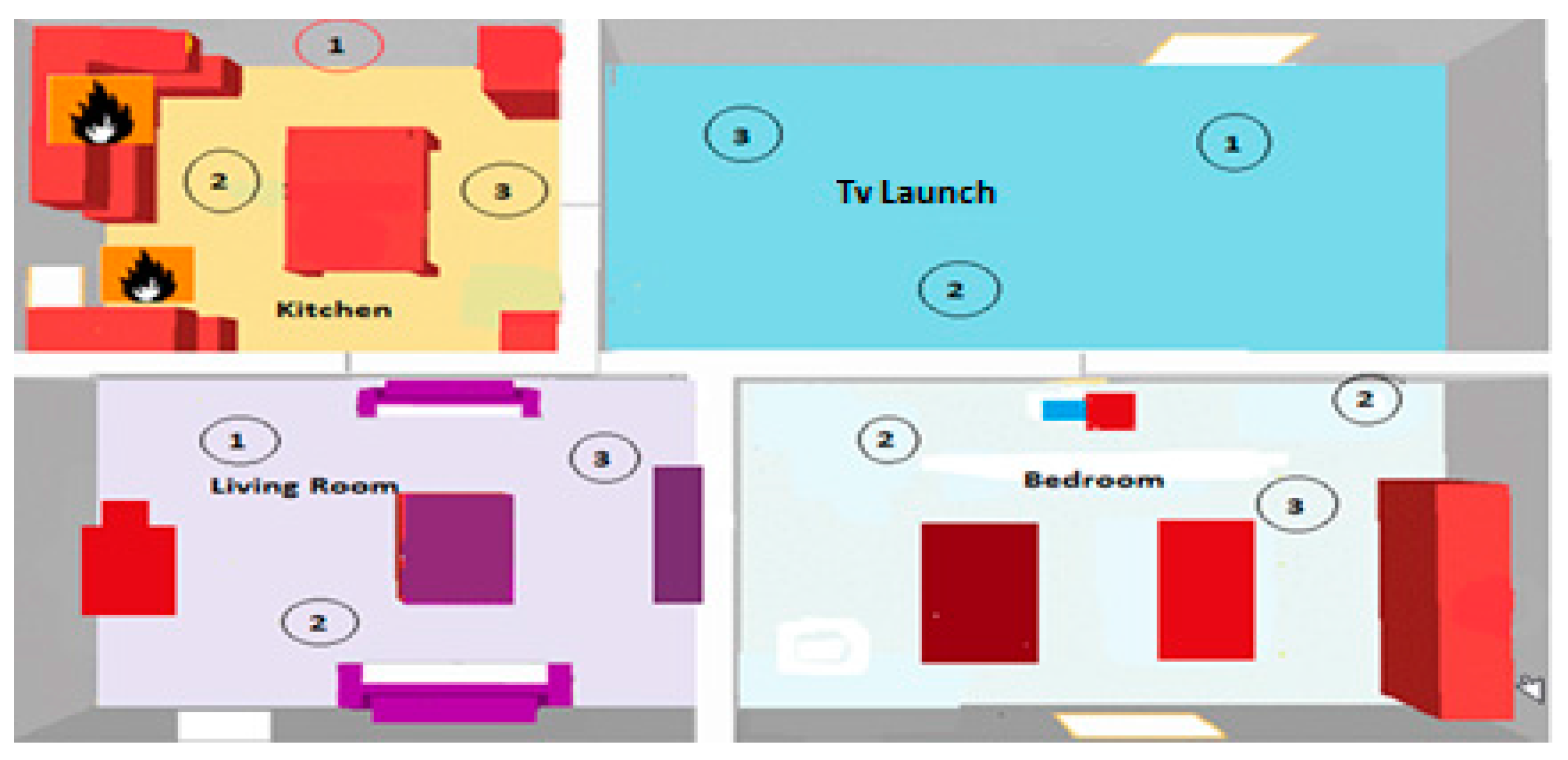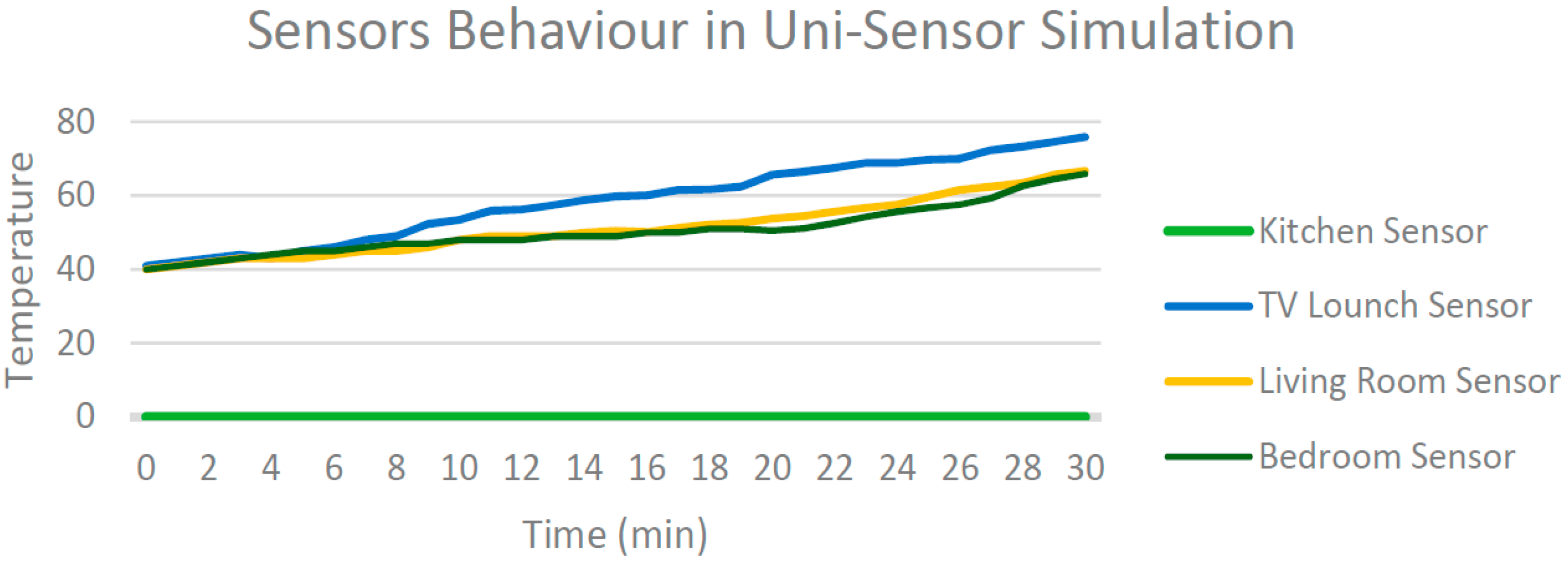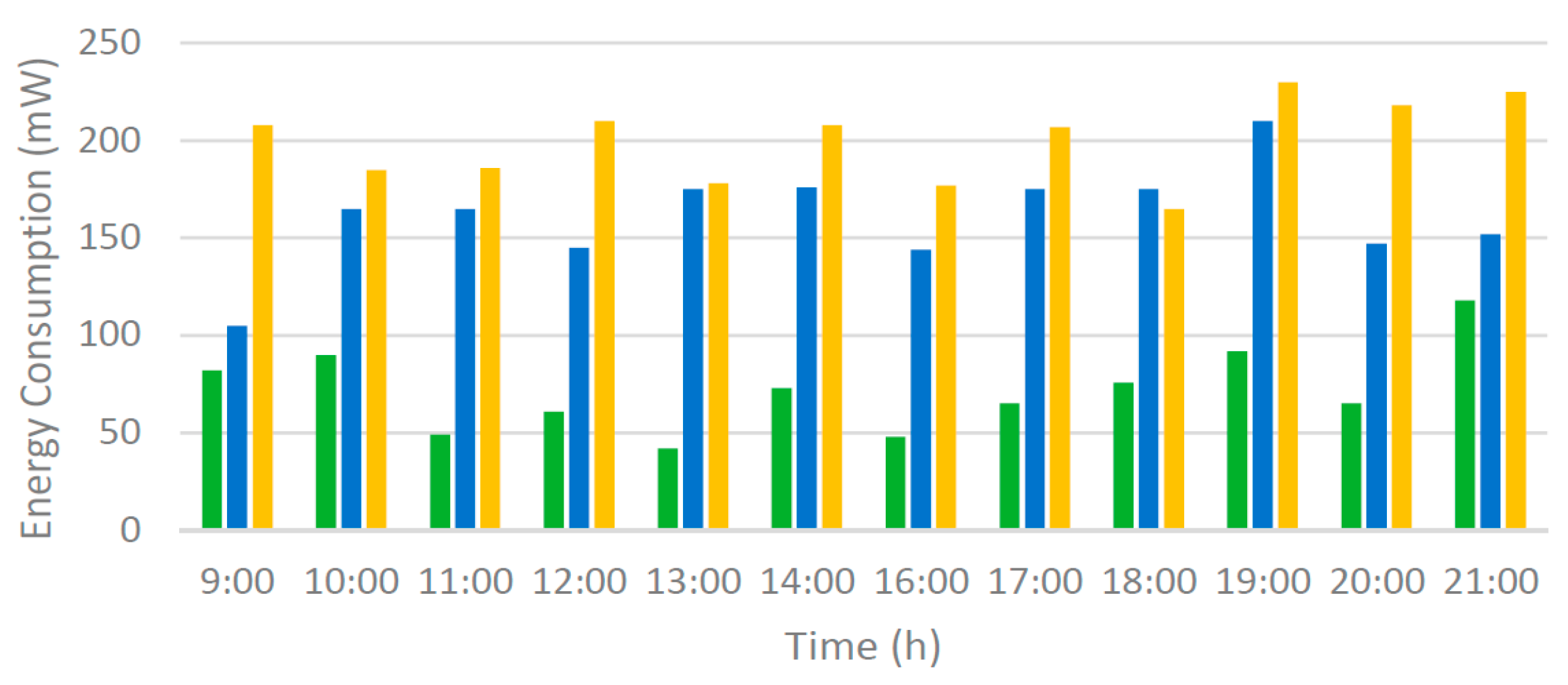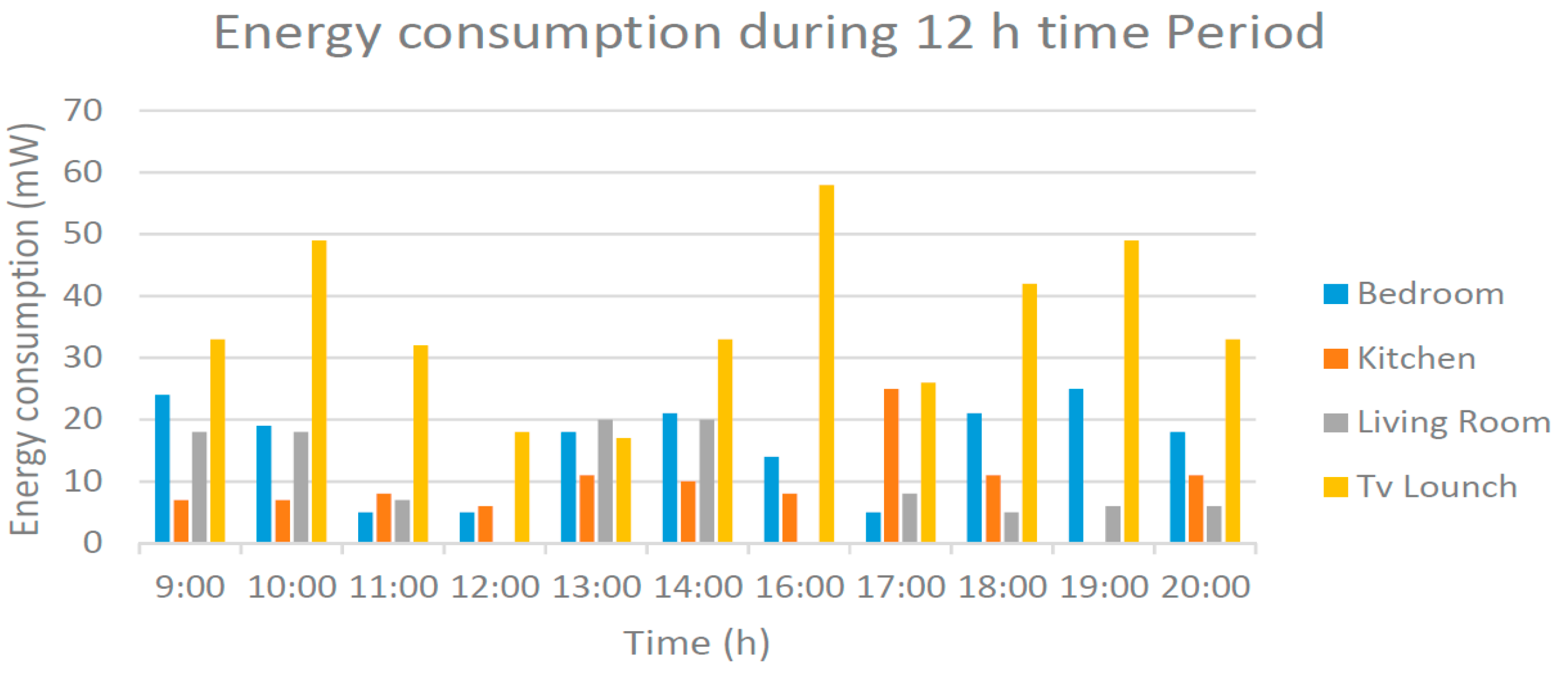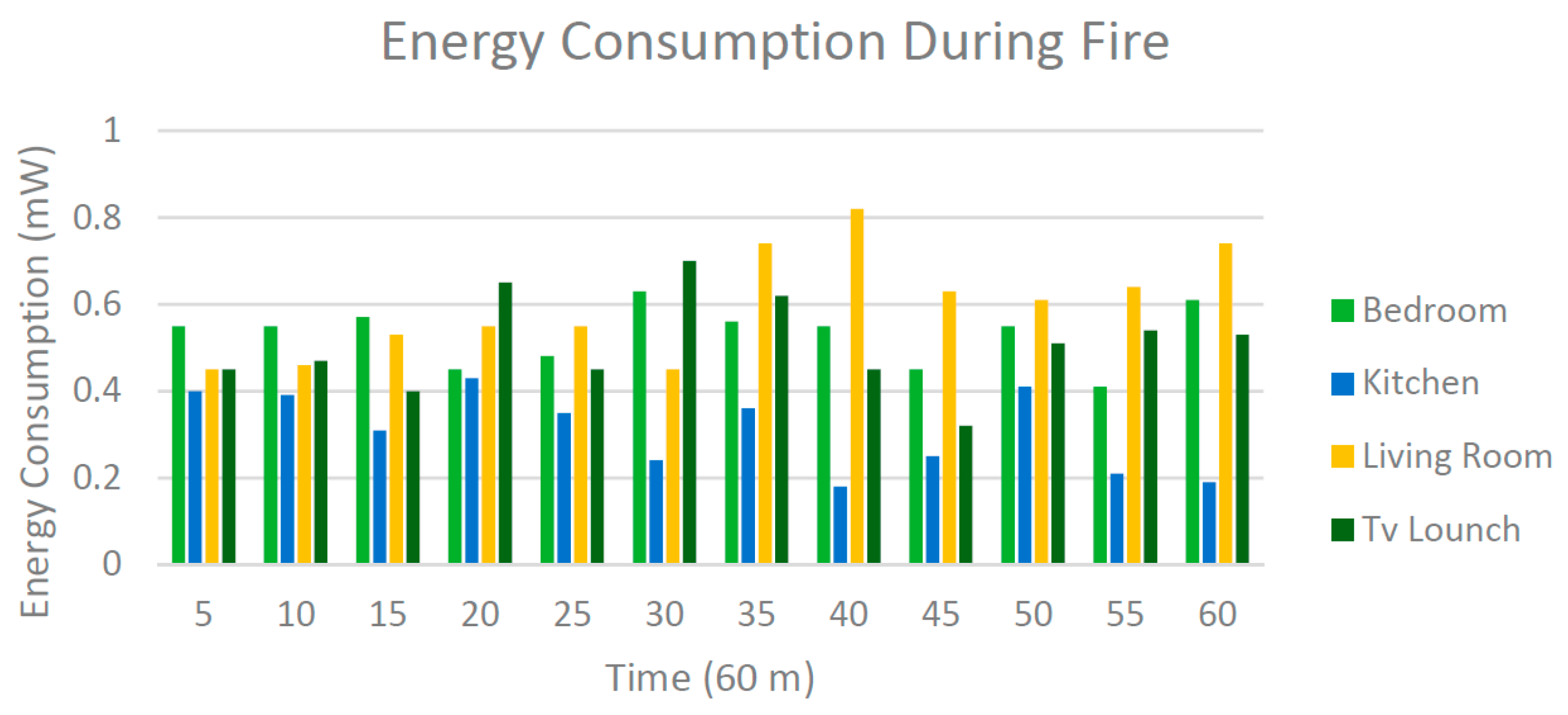1. Introduction
In recent years, fire detection has become a very big issue, as it has caused severe damage including the loss of human lives. Sometimes, these incidents are more destructive when the fire spreads to the surroundings. Early detection of a fire event is an effective way to save lives and reduce property damage. To escape a fiery place and to douse the fire source, the fire must be detected at its initial stage. The installation of a fire alarm system is the most convenient way to detect a fire early and avoid losses. Fire alarms consist of different devices working together that have the ability to detect fire and alert people through visual and audio appliances. The detection devices (i.e., heat, smoke, and gas detectors) detect events and activate the alarm automatically, or sometimes the alarms are activated manually. The alarm may consist of bells, mountable sounders, or horns.
Most of the fire alarm systems use the technology of a wireless sensor network (WSN). WSNs have gained popularity because they have a variety of uses in different applications, such as target tracking [
1,
2], localization [
3], healthcare [
4,
5], Smart Transpiration [
6], environmental monitoring, and industrial automation [
7]. WSN is also used in collecting data and monitoring, both autonomously or with the help of users [
8,
9]. WSN applications also help human and animals [
10,
11] and are also used for industrial purposes, for example, underground pipeline monitoring. In a WSN, sensor devices are often very tiny, battery-powered, and densely populated with the functionality of monitoring several parameters of the environment. The sensed data are sent to the main collecting unit (i.e., the sink, cluster head etc.) for processing [
8]. WSNs used for fire detection systems also have the same functional properties. Each sensor detects rising heat, smoke, or gas in some spots in a home and generate san alert in its head node in a network. The head node collects reports from various sensors and identifies the presence of a fire. Next, different heads coordinate the received inputs and consult with a remote command center to plan a response that may consist in a simple fire alarm generation or in complicated evacuation methods. Numerous technologies based on WSN have already been proposed to detect fire. Some of them are stand-alone with WSN, and some have hybrid technologies. There are many event detection systems, which help to identify heat, gas, and smoke.
Today, smart houses and smart cities are equipped with different type of WSNs [
12]. In WSNs, more energy may be consumed because of communication overhead. Thus, most of the time, a sensor’s battery is exhausted very fast and it may cause the failure of the sensor or the breakdown of whole network, as houses have different sub-portions and each portion is equipped with one sensor with a single function, which in case of failure causes a system flaw. In this scenario, if an event occurs in a certain portion and the sensor fails to detect the accident, then there is no other way to detect the incident at its initial stage. As unifunctional sensors are only be able to detect one event, there is another noticeable issue regarding the possibility of false alarms. For example, a heat detector detects temperature in the environment and produces the alarm if the temperature increases beyond a threshold. However, the increase in heat may be due to environmental changes or human activity in the room. In the case of smoke detectors, the smoke may come from outside or from other sources. The cost of a false alarm is estimated between
$30,000 and
$50,000 per incident [
13].
Today, sensors are very cheap and very small in size. Thus, to address the above-mentioned challenges, we propose an efficient, IoT-based intelligent home fire prevention system using multiple sensors. Each of the sensors uses its own mechanism for detection. Our method detects fire very efficiently and reduces false positives by using Global System for Mobile Communications. The contribution of this article is manifold.
Problems and challenges related to the current approaches are identified. The existing methods use single sensor for each target regions. Nowadays, sensors are very cheap so we used multi-sensors for every critical region to address problems linked to single sensor detection.
We use GSM communication to alert the user at early stages if the sensor reports a fire.
The identification of the fire is made by the system after verification from two sources. These sources are: (1) Response of the user to the GSM alert, i.e., if the user response is fire, then our system directly generates the alarm; (2) When two or more sensors report fire, then the system directly generates a fire alarm without waiting for the user response.
We use star topology for the deployment of sensors and communication between sensors and main home sink. We use the ZigBee protocol to provide communication between the sensors and the sink.
Finally, we evaluate the system concerning energy consumption.
The rest of the paper is organized as follows. The related work is presented in
Section 2.
Section 3 discusses the analysis of fire data.
Section 4 describes the overview of our proposed work and the detailed design of the fire detection system. Simulation details and results are exposed in
Section 5 and
Section 6, respectively. Finally, the article is concluded in
Section 7.
2. Related Work
In the last few years, sensors have been widely used for fire detection [
14,
15,
16,
17,
18,
19]. Silva et al. [
14] proposed a work for fire detection in mines by using wireless sensor networks called WMSS. For determining the hazardous factor in the mines, they used gas sensors and designed a wireless sensor network which collects and analyses the gas level in mines. The work proposed in [
15] used Zigbee-based wireless sensors for fire detection in forests. They used temperature sensors to establish the intensity of fire in a forest. They used a CC2430 chip in their hardware design for network nodes. Similarly, Buratti et al. [
16] also designed a framework for forest fire detection. In their work, they used a model for fire detection using different clustering schemes and communication protocols. They performed the simulation for validation and evaluation of their work. W. Tan et al. [
17] implemented a work for forest fire detection. They used multi-sensor and wireless IP cameras to avoid false alarms. Their system also connected to the internet via gateways for uploading the data to the cloud. A work proposed in [
18] for forest fire detection was based on a ZigBee wireless sensor network in China. A work for forest fire detection is proposed in [
19]. A. Rehman proposed a work for WSN [
20]. South Koreans [
21] also designed a system for fire detection in their mountains. They named their system FFSS (Forest fire Surveillance system). They developed their system by using WSN, middleware, and web applications. Network nodes (i.e., temperature sensors and humidity sensors) collect measurements and send them to the sink node. Afterwards, the sink node transmits that data to the cloud via a transceiver (gateway). Later, by using a formula, the fire risk level is determined in the middleware program. After detecting the fire, FFSS is activated automatically. TinyOS is used as an operating system for network nodes.
Similarly, few other systems utilize the WSN for early fire detection. Few of them use IP-based cameras and mixed multi-sensors [
22] on wireless mesh network to detect a fire efficiently. They use these three parameters to make an efficient system to identify and verify fire. A software application exists, which selects the closest IP base camera. When sensors sense a fire, they send the information to the central server where the software program selects the nearest camera. That camera takes pictures of the location and send them back to the main sink. Alarm decision is made on the basis of the sensor’s information and selected images. Also, a clustering-based forest fire detection system was proposed in [
23]. The proposed method uses advanced communication protocols. The proposed work consists of four major parts: (i) an approach for sensor deployment, (ii) the use of WSN for fire detection, (iii) intra-clustering protocols, and (iv) an inter-clustering communication protocol. Aother work was proposed by Wenning, Pesch, Giel, and Gorg [
24] for disaster detection, including the fire event. This method can quickly adapt the routing work state on the basis of the threat of possible failure. In [
25], researchers proposed a protocol for the adaptation of the Context-Aware Routing Protocol (CAR) to WSN and named it SCAR. Energy, colocation with sink, and their connectivity was evaluated in SCAR. For the delivery of data packets to the sink, delivery probability and forecasted values were combined on the basis of previous knowledge of SCAR parameters. In this system, buffer space and delivery probability are exchanged periodically with neighbor nodes. An order list of neighbors is sorted by delivery probability, which is kept by each node. Garcia et al. [
26] proposed a work to create a model for fire detection. They performed a simulation by analyzing sensors data and geographic information. To differentiate from the existing work, they used topography of the environment under study.
Energy and time factors are an unavoidable requirement that should be satisfied efficiently. The energy factor plays a vital role to maximize the lifespan of sensors in the WSN environment. The ever-increasing demand by the market leads the researcher to invent new hardware and algorithms that are more reliable and efficient. IEEE 802.15.4/ZigBee with cluster-tree topology [
27] assures reliable performance and efficient energy consumption that significantly increases the lifespan of WSN. This IEEE standard reduces the time slot collision named guaranteed time slot (GTSs). GTSs can also be used in real-time transmission scenarios. Allocating GTSs to the sensor nodes indicates that nodes will remain in sleep mode until they get a time slot. Other anomalies, such as optimal sensor placement, data communication, security, and sensor’s energy factors, are also involved in sensor environments. A considerable amount of work has been done in this domain. Gul et al. [
28] proposed a work that optimized the sensor node placement and analyzed the energy constraints on a significant amount of data passing through the WSN while the network was suffering from a DDoS attack. Techniques like the Constrained node-weighted Steiner tree-based algorithm [
29] have proven to be helpful while creating WSN. This technique optimized the sensor node placement efficiently. A proposed method [
30] maximized the lifetime of a sensor by optimizing data aggregation. Intelligent systems, from vehicular networks to the smart buddy and other evolutionary systems, are applied in various fields of technology [
31,
32,
33,
34,
35] which also poses many challenges in implementation, especially in analyzing fire simulations without human intervention.
3. Home Fire Data Analysis
To understand the importance of the study, we did some analysis by using different fire datasets. We took these datasets from very reliable sources [
36,
37]. The datasets include fire statistics containing: (i) a percentage of homes that have fire alarms in England & Wales, (ii) causes of the fires, (iii) fire alarms with respect to sensors type, and (iv) death data per million population because of dwelling fires. While analyzing the house fire data initially, we examined the trend of using alarm during the years from 1988 to 2015.
Figure 1 shows the graph of this trend. It shows that almost 93.4% of houses in English countries are now using fire alarms.
As this analysis shows, almost 93% of houses are equipped with fire alarms but the study indicates that there are still many deaths despite the fire detection systems.
Figure 2 shows the pictorial representation of the analysis of the death dataset taken from [
37]. The graph shows the number of deaths per million people in each year. The study shows that more than ten deaths per million population are still occurring every year. The loss of lives or property caused by fire is due to many reasons, such as alarm failure, false alarm, no response, and many other unspecified reasons. We performed another analysis of fire-caused losses where fire detection systems were installed. This analysis was made on the data taken from England between 2010 and 2016.
Figure 3 shows the study of fire-caused losses per year. We analyzed fire losses due to three causes: (1) Fire damages due to a false alarm, (2) Fire losses due to no person response, (3) Other/unspecified reasons. The analysis shows that most of the losses were caused by false alarms. As we described earlier, most of the fires are not detected because of sensors’ failure and thus progress. Most of the houses examined were equipped with WSN-based fire alarm systems.
Most of the time, alarm failures are due to the breakdown of the WSN. In the WSN, the association between sensors is essential. Therefore, the communication between sensors cannot be performed if the network is disconnected. So, the failure of a single sensor may result in many harsh events. Most of the sensors are battery-powered and might not have the possibility to recharge. Most of the energy is spent in communication, and, if the sensor energy is exhausted during communication, sensor failure occurs, and this can sometimes lead to network failure. We performed analyses on alarm’s failure in the presence of a fire detector sensor. The analysis results are shown in
Figure 4. The analysis graph displays the percentage of true alarm generation and sensors failure with respect to the different categories of sensors from 2010 to 2016.
4. IoT-Based Intelligent Modeling of Smart Home Environment for Fire Prevention and Safety
In this section, we breakdown of our work into four parts. The first unit describes the sensor which collects the information from the environment and transmits it to the second unit, i.e., the processing unit, by using the ZigBee protocol. The third unit is the GSM communication unit, which alerts the users about the event. The fourth unit triggers the alarm. Details of these units are as follows.
4.1. Overview
The existing systems have flaws because they contain single unifunctional sensors for each target portion in the residential place. However, if an event occurred in a particular place and the sensor of that region was not working, then it would be highly improbable to detect the incident at its initial stage. The second major problem is the generation of false alarms. The proposed smart home fire detection system consists of four major parts: (i) sensor; (ii) processing unit as the main home sink; (iii) GSM communication system; (iv) alarm system. In the sensor unit, we deployed multi-sensors, i.e., smoke, gas, and heat sensors for each portion of the smart homes. All these sensors have their own event detection mechanism.
Figure 5 shows the complete model of our proposed work. The processing unit contains a home sink, which communicates with the sensors through the ZigBee Protocol. The decision of fire detection is taken on the sink on the basis of the information received from the sensors and of the user’s response. If a single sensor node sends fire alert to the sink, it automatically activates the GSM communication and sends an alert message to the user. The sink make decisions on the basis of the user’s response or of the alert notification from the other sensors. After getting confirmation of a fire event either from two or more sensors or from the user, the sink generates an alarm. Simultaneously, the system shares the event information with the cloud and with the local server which helps to spread the information to the basic service units. The local server is connected with the surrounding inhabitants to inform the other houses about the current situation. We present the detail design of each unit in the following subsections.
4.2. Sensors
The products derived from the fire are heat, smoke, gas, or infrared/ultraviolet radiations. The sensors can detect one or more of these phenomena. In our model, we used smoke, gas and heat sensors to detect changes in the above-mentioned aspects. The temperature sensors are mainly designed to detect changes in temperature. Temperature sensors are classified into two classes according to their operations, i.e., (i) rising rate of heat (ii) fixed temperature. The LM35 (Texas instrument, China) is a temperature sensor which is very efficient and highly calibrated. This sensor is used to detect the rise in temperature. It may have attributes such as less heating and low linear impedance. It can operate in the voltage range from 4 V to 30 V which is lower than 60 μA of drain current [
38]. The smoke sensors are devices that can detect smoke from a fire. The smoke sensors are packed in a plastic cage varying in size and shape, but mostly disk-shaped, 25 mm thick, and 150 mm in diameter. MQ9 (Henan Hanwei Electronics Co., Ltd., Zhengzhou, China) is a smoke sensor made of microaluminum oxide which is used to detect smoke in a room. In order to detect the smoke, this sensor combines the high sensitiveness of carbon monoxide and a layer of in oxide. It contains very sensitive components, work conditions, and measuring electrodes [
39]. During a burning fire, the gases produced (e.g., carbon dioxide, carbon monoxide, and many others) are very hazardous. The devices which are used to detect gases like CO, CO
2, etc. are called gas detectors. These devices are used to identify toxic, combustible, flaming gases, and also depletion of oxygen. These devices can be grouped into different classes (infrared, photoionization, catalytic, semiconductors, oxidation, etc.). They are available in two primary forms: (i) portable devices (ii) fixed gas detectors. MH-Z19 NDIR (Zhengzhou Winsen Electronics Technology Co., Ltd., Zhengzhou, China) is an infrared gas detector which is quite common. These sensors are tiny, have a long life, and work on the principle of non-dispersive infrared (NDIR) to detect the presence of carbon-dioxide in the air very efficiently.
In proposed work, we used these three sensors for each sub-portion and set a threshold for these sensors. For the kitchen environment, we used different limits. The sensors sense the environment and collect data in raw form. If the sensed data is higher than a threshold, which is δS, then the sensor reports the information as fire. This report goes to the sink which works as a processing unit that analyzes the report.
4.3. ZigBee as the Used Communication Protocol
To set up the wireless sensor network, it is possible to use different topologies, depending on the number of sensor nodes and communication methods. The four most common topologies are: (i) The peer to peer, (ii) The mesh, (iii) The tree, and (iv) The star network topologies [
40]. Comparatively, the star network topology setup is very competent compared to other network topologies.
Figure 6b shows the star network topology. For communication between the sensor and the home sink, we used the Zigbee protocol.
Figure 6a shows the communication method. ZigBee is based on IEEE 802.15.4 standard specification and uses high-level communication protocols to build personal local area networks. It uses tiny, low powered, digital radio devices and it can be used to transfer data over some limited distance from 10 to 100 m. This distance depends on the environmental conditions, and it varies for different homes. It is considered a low-powered protocol because it needs a minimal amount of energy to receive and transmit data.
It consumes most of its energy in transmitting the data. This protocol uses different types of devices like: (i) Coordinator; (ii) Router; and (iii) End devices. ZigBee uses as a coding technique the direct sequence spread spectrum, abbreviated as DSSS. Therefore, it uses two primary types of communication modes, i.e., (i) Beacon-enabled and (ii) Non-beacon enabled. The outlines of the beacon-enabled and non-beacon-enabled communication are shown in
Figure 7a,b [
41]. In beacon-enabled communication, the beacon frames or beacon packets are broadcast periodically by the PAN coordinator [
41]. In non-beacon-enabled communication, the PAN coordinator broadcast the beacon packets randomly. When the sensors are in the inactive state or do not send the data, this protocol automatically turns off its interface to save energy. When it sends beacon messages, the nodes remain in the active mode. Usually, beacon intervals are between 15.36 ms and 251.65 ms at the speed of 250 kb/s, but this depends on the data flow rate. By keeping in mind this ZigBee communication model, we used ZigBee for data communication.
4.4. Processing Unit
The information collected from the sensors is then sent to central processing hub or main home sink wirelessly. Nowadays raspberry pi, abbreviated as (RPI), is being used as the primary processing unit. The main reasons for choosing it are its popularity and versatile functionalities. This device works as a processing unit and processes the data that comes from sensors to decide whether to activate the alarm. To handle the information which comes from the sensor nodes, RPI starts initializing the modules that are required for that specific processing. For example, in our proposed method, we used SMS alert system via GSM technology and then GPIO general purpose input–output. If the measurements that come from the sensor nodes consist of a fire alert, the GSM module is activated and send an alert SMS automatically to the specific user. The general purpose of the input–output GPIO module is to check the user response to the fire. This response will always be in the form of “yes” or “no”.
If the response is “yes”, this means a fire is present, but if the response is “no”, that means no fire. For each of the deployed sensors in homes, the GSM module gets activated automatically. The final decision of alarm depends on both the user’s response and the sensor’s readings. The flow diagram of this system is shown in
Figure 8. If a single sensor’s reading contains a fire alert message, then the system does not make any decision on behalf of this single reading. The system waits for the response to a pre-warning SMS. After receiving a response to the pre-warning SMS, that can be either “yes” or “no”, the alarm will be activated if the response is “yes” or if the system receives the event notification from two or more sensors.
4.5. GSM Module
As the expenses of a false alarm are very high, to avoid this flaw, we used a module, i.e., the GSM. In the kitchen environment, there are more chances of false alarms a, temperature, smoke, gas, and UV or IR radiations are usually present in the atmosphere. Currently, GSM modems such as WaveCom and Multitech have the functionality of the SMS mode. Instead of encoding the binary PDU of messages, this text mode allows the home sink to send a pre-warning alert to the user by using AT commands. The pseudo code for the GSM module is listed below:
Open serial port of RPi device and connect the 3G modem.
Set phone number and message content.
Send “AT” commands for SMS to be sent
Disconnect phone.
4.6. Algorithm of the System
The algorithm of our proposed work is shown in Algorithm 1 and
Table 1.
Table 2 shows the notations used in the algorithm.
| Algorithm 1: Proposed Work Algorithm |
(1) For each (among all sensors) do
IF (Sen_Val > δs) Then
Report = 1;
Alert();
Next();
Else
Report = 0;
Next();
//Alert Function Algorithm on right side of the table
(2) For each (For all report as fire) do
Open();
Connect();
Commands();
Send(Rsp);
Disconnect();
//Sink Decision Algorithm
(3) IF (Two sensor Report Fire or Response = 1)
Alarm();
Else
Next(); |
5. Simulation
To evaluate the efficiency and effectiveness of our proposed work, we simulated fire in a smart home using the Fire Dynamic Simulator, abbreviated as FDS [
42]. FDS is a tool developed by NIST to simulate a fire in different environments. It is a computer language program which solves Navier–Stokes Equations numerically. It is written in FORTRAN and it takes multiple inputs like: (i) Sensors thresholds; (ii) Initial values of sensors; (iii) Humidity; (iv) Different parameters to design the environment, and many more. By using these inputs, it computes the Navier–Stokes Equations.
Figure 9 shows our simulated work scenario using FDS. We divided the house into four parts, i.e., (i) Bedroom; (ii) Living room; (iii) Kitchen; (iv) TV Lounge. To monitor fire, we examined three different parameters, i.e., temperature, gas, and smoke. For each portion of the house, we used three sensors, while 12 thermocouples were used in whole. The initial inputs of the sensors were 25 °C, 15 ppm, and 60 ppm for temperature, gas, and smoke sensors, respectively. We ignited the fire in the kitchen and we assumed that it started 30 min after the beginning of the simulation. After the fire started, it spread at a rate of 1500 KW/m
2.
We performed the simulation for both scenarios, first in the presence of a single unifunctional sensor and then in the presence of the multi-sensor. For the first scenario, we used temperature sensors to monitor the fire. As the fire started from the kitchen, we made this sensor inactive and continued the simulation for 40 min. For the second scenario, we performed the same simulation and setup, as shown in
Figure 9. We measured the data generated by the simulation for these two scenarios.
To check the efficiency of our work, we also implemented our proposed method by using C++ programming language. We performed our implementation in visual studio 2017 in which we used C++ libraries. We installed our simulation environment and visual language on a machine with specification “Intel(R) Core(TM) i5-3570 CPU @ 3.40 GHz 3.80 GHz and RAM 16 GB”. The data produced by FDS during fire simulation was used for our algorithm to check the efficiency of our work.
